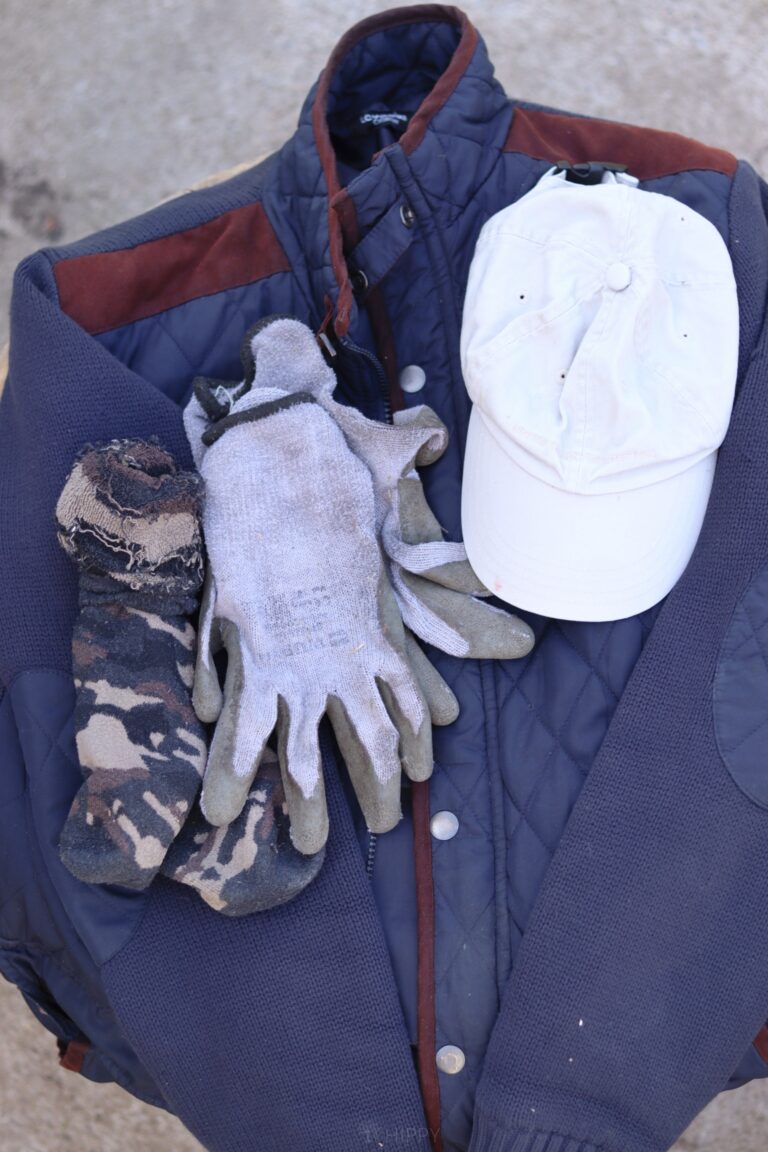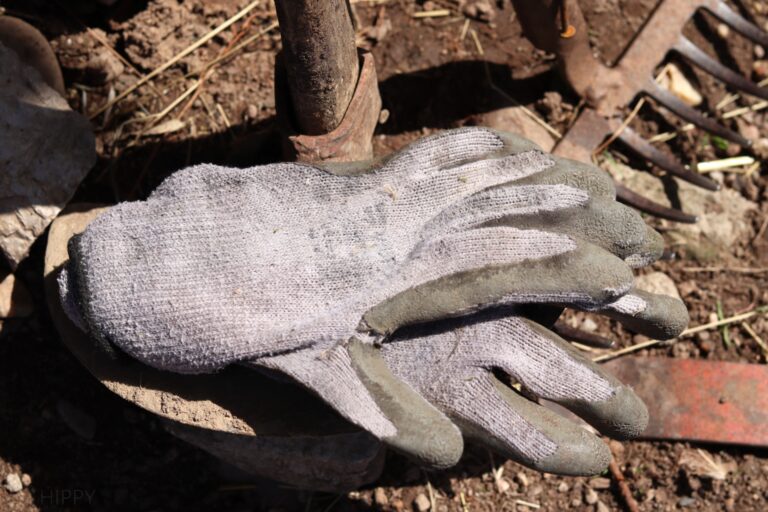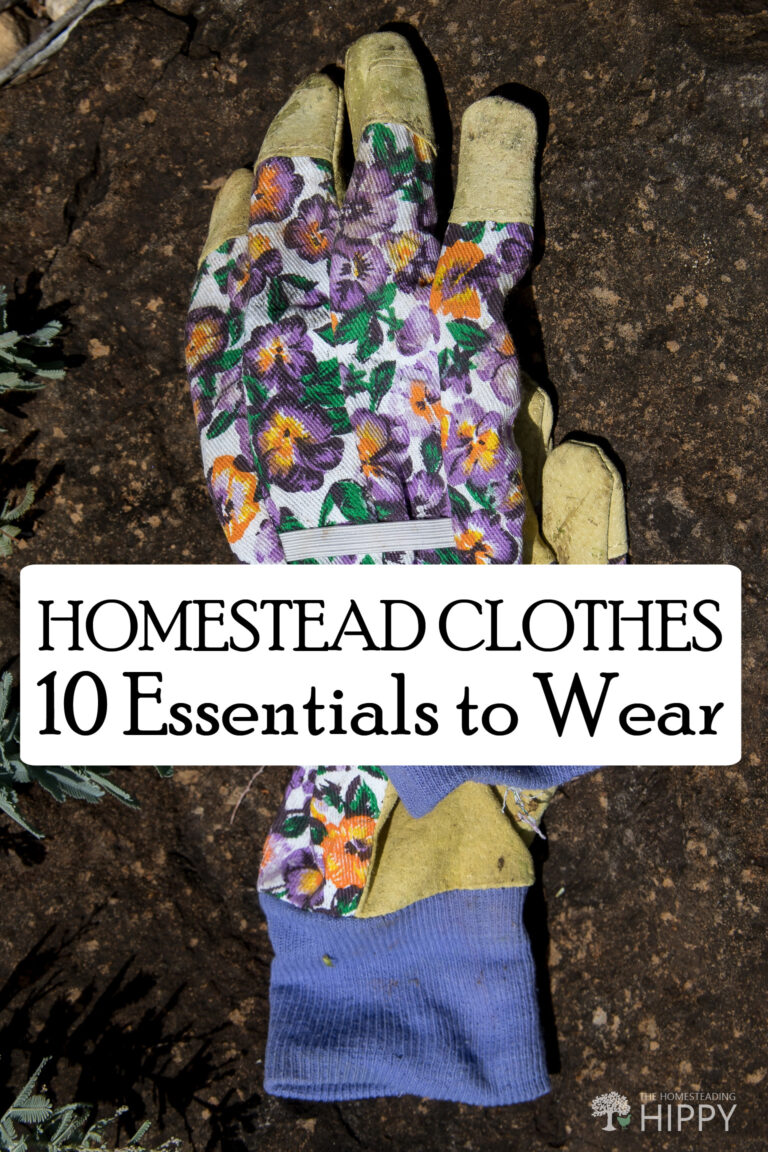We’ve all heard about dressing to impress and having the right tool for a particular job. When it comes to homesteading, your clothes are as much a tool as your tools are.

Being dressed appropriately allows you to work quickly, efficiently, and comfortably. It also provides a level of safety from certain possible dangers – this is particularly true on a homestead.
With all that in mind, what are some essential items of clothing that one should have and/or wear? Here are the main ones we’re going to cover today:
- Gloves to protect your hands.
- Jeans/long pants to shield your legs from the sun.
- Thermals to keep yourself warm in the winter.
- Hats to keep your face and eyes out of the sun.
- Boots/closed shoes to protect your feet.
- Jackets to keep the cold and wind off you.
- Shirts to keep your skin shielded from the sun.
- Socks to keep your feet warm.
- Glasses to keep your eyes safe.
- Overalls to protect your clothes if you’d prefer not to ruin certain items of clothing.
- Sunglasses
- Vest
With that in mind, here are some clothes to add to your shopping cart! This apparel is absolutely essential for the wardrobe of just about any homesteader, so make sure you stock up today.
Homesteading Clothes You Should Consider
1) Work Gloves
Gloves, not really something you’d think of when thinking of ‘essential clothing’, but they can be a crucial tool for a homesteader.
You’ll probably have multiple sets of gloves lying around for everything from keeping your hands warm to gardening to working with power tools (i.e. grinders, welding machines).
The use of gardening gloves keeps your hands relatively safe from insect and spider bites. They also prevent you from touching anything poisonous.

Sparks given off by certain power tools can burn your skin. A pair of thicker, heavier gloves can keep your hands safe from being burned.
2) Jeans / Long Pants
Generally speaking, it’s a good idea to stick to long pants or jeans. Apart from being good for keeping your legs warm in winter, long pants/jeans place a barrier between the sun and your legs.
Prolonged exposure to the sun can put you at risk of skin cancer – which is obviously not good. Additionally, sunburn behind your knees is really uncomfortable!
Now, while I’m more of a jeans guy, you can also use a pair of leggings or cargo pants – pick your poison – if they’re comfortable and they cover your legs and keep them out of the sun you can use them.
3) Thermals
Thermal wear is usually worn under your clothes, and is meant to maintain your core temperature by trapping body heat.
If you’re working in colder weather, then wearing thermals under your usual attire will help keep you warm.
4) Hats
Hats and caps are also essential for homesteaders! Whether it’s a knit cap for winter weather or a wide-brimmed hat for summer, these are a few more accessories you’ll want to add to your shopping list.
You obviously don’t want to get sunburns, so you use a hat to keep the sun out of your eyes and off your face. You can use either a baseball cap or a broad brimmed cowboy-style hat.
The cowboy hat would probably be the better option if you’re going to be out in the sun for long periods as it can also keep your neck relatively covered.
5) Boots / Closed Shoes
Sandals might be more comfortable to wear in the summer, but it also puts you at risk of snake and spider bites.
Snake and spider bites aside, you’ve also got thorns, and sharp rocks to worry about and when working with power tools you should have some form of protection from things that may fall on your feet.
Additionally, your cows and horses’ habit of stepping on your feet won’t be as painful.
Something to keep in mind when it comes to your shoes, is the variety of weather conditions.
Some types of boots are more waterproof than others and are great for working in wet/rainy conditions. It’s probably a good idea to keep a few pairs for rainy and snowy weather.
Here are a few type of boots you’ll want to consider having in your closet:
6) Work Boots
There are many reasons why homesteaders need to wear work boots. First of all, they provide essential protection for your feet. If you’re working with tools or in the garden, you could easily hurt yourself if you’re not wearing boots.
Boots also help to keep your feet warm and dry, which is important when you’re working outside in the cold or in wet conditions. In addition, they provide good traction on slippery surfaces, which is essential for safety.
There are a variety of different types of work boots available, and the best type for you will depend on the type of work you’re doing.
For example, if you’re going to be doing a lot of logging, you’ll need a pair of logger boots with steel toes. If you’re going to be hiking, you’ll need a pair of hiking boots.
And if you’re going to be working in icy conditions, you’ll need a pair of insulated boots.
7) Muck Boots
Muck boots are a type of rubber boot that is designed to keep your feet dry and comfortable in wet or muddy conditions. They are often used by farmers, gardeners, and other outdoor workers who need to protect their feet from the elements.
In addition to being waterproof, muck boots are also breathable and insulation, making them ideal for use in a variety of different climates.
For homesteaders, muck boots are essential for tasks such as working in the garden, caring for animals, or even just going for a walk in the woods.
They can help you stay comfortable and dry no matter what the weather is like, and they will protect your feet from both the elements and any hazards you may encounter while working around your property.
8) Jackets
Winters here in South Africa can see temperatures of -2 degrees Celsius – windier days are colder.
With that in mind, everyone here bundles up in the heaviest possible jackets we can find. Jackets are great for keeping the wind chill off you while you’re working outdoors in the winter.
Much like the boots and gloves, you’ll want to keep multiples around so that you have a jacket for everything. You’ll want a thick, heavy jacket for the colder months and a thinner, lighter one for the warmer, rainier months.
9) Shirts, New and Old
Okay, apart from the obvious fact that you have to wear a shirt anyway; a shirt keeps the sun and wind off your skin and ideally you should have a mixture of new shirts – for family gatherings and such – and old shirts for the days of hard labor where your clothes are likely to be torn up.
You’ll want to stock up on a few types of shirts.
A tank top is helpful when it comes to working outside in hot weather, while flannels will provide necessary warmth during winter chores. Nothing wrong with a few t-shirt options, either!
When selecting shirts, try to find some that have some extra room in the waist but not in the sleeves. For most homestead projects, you aren’t going to want baggy sleeves, since these can get caught in things and cause you to injure yourself or others.
A good button-down shirt will work wonders, since it makes it easier to layer on top of or underneath under clothes.
10) Socks
Socks…yes, socks are essential; the primary use for them is to keep your feet warm. A second function would be to provide a certain amount of protection from blistering – I don’t think I need to tell you that blisters under your feet are very painful.
With that said, you also want socks that will stay around your calves as much as possible – if they keep slipping down your leg it’ll drive you nuts.
Unfortunately, socks get worn through pretty quickly so you’ll have to keep many, many pairs of socks in your closet/dresser.
11) Glasses
Okay, so this is more for when you’re working with power tools or when working in a manner where something may get into your eyes.
Tools like grinders, jigsaws, and, to a point, hatchets can send up dust, sparks, and woodchips which would damage your eyes if they came into contact with them.
12) Overalls
One of the most useful pieces of clothing you can have on hand is a set of overalls. The more sets you have the better because they won’t last very long when you’re busy with outdoorsy work.
They work to protect your clothes from being torn up which can save you a few cents on shirts and jeans every few months.
13) Sunglasses
Glaring sun. August. Trying to harvest crops. Need I say more?
I prefer polarized sunglasses with a no-slip grip, but get whatever you think will work best!
14) A Vest
A vest is a versatile and essential clothing item for any homesteader. It can be worn over a shirt for an extra layer of warmth, or it can be used as a standalone outerwear piece.
Vests are also great for layering, as they provide an additional layer of warmth without making you feel bulky or constricted. In addition, vests are perfect for storing small items like a pocket knife, matches, or a flashlight.
Whether you’re out working in the field or just enjoying a leisurely walk around your property, a vest is a necessary piece of clothing for any homesteader.
Where to Get Good Deals on Homestead Clothes
Looking for some new clothes but not interested in spending a lot of money? Check out your local thrift store! You can find everything from shirts and pants to shoes and purses, all at a fraction of the price you would pay at a regular retail store.
Plus, most thrift stores have a size chart handy so you can be sure to find something that fits. And if you’re really lucky, you might even find something with the tags still on!
Don’t have time to go thrifting? No problem. There are plenty of ways to get good deals on homestead clothes without leaving your house.
Check out online thrift stores or take advantage of rewards programs and discounts offered by regular retail stores. And don’t forget about curbside pickup and exchange policies – these can often save you time and money (and time is often just as valuable as money when you’re a homesteader).
What Are the Best Clothing Brands?
For those who enjoy the rural lifestyle, there is nothing quite like the feel of homegrown produce, the scent of fresh-cut timber, or the sound of a rooster crowing in the morning. But while the homesteading life can be rewarding, it can also be tough on your clothes.
That’s why it’s important to choose clothing brands that are built to last. Among the most popular brands for homesteaders are Carhartt and Wrangler.
Carhartt offers a wide range of durable workwear, from heavy-duty jeans to sturdy boots. Wrangler is another great option for homesteaders, offering a line of tough jeans that can stand up to any task.
One final brand for women’s clothing and kid clothing in particular is Columbia. While this gear isn’t as well suited for heavy work in the barns like Wrangler or Carhartt, Columbia makes some of the best outdoor gear for winter.
Can You Make Your Own Homestead Clothes?
Making your own clothes is a great way to express your creativity and connect with the homesteading lifestyle. And with a little time and effort, you can create homemade clothing that is both stylish and practical.
However, there are a few things to keep in mind before you get started. First, you will need to choose the right fabrics. Natural fibers like wool and linen are ideal for homestead clothing since they are durable and easy to care for.
Second, you will need to invest in some basic sewing supplies. A sewing machine will make the process much easier, but you can also hand-sew your clothes if necessary. Finally, be sure to take your time and enjoy the process! Conclusion
Conclusion
Well, there you have it; a list of essential clothing items for homesteaders to use. If you’re looking to get into homesteading, then I hope this article helps you know which clothes you’ll need.
With a little bit of effort, you’re sure to find the perfect outfit at the perfect price. Happy shopping!


Greg spent most of his childhood in camping grounds and on hiking trails. While he lives in the suburbs nowadays, Greg was raised on a small farm with chickens. He’s a decent shot with a bow, and a huge knife enthusiast. Find out more about Greg.
